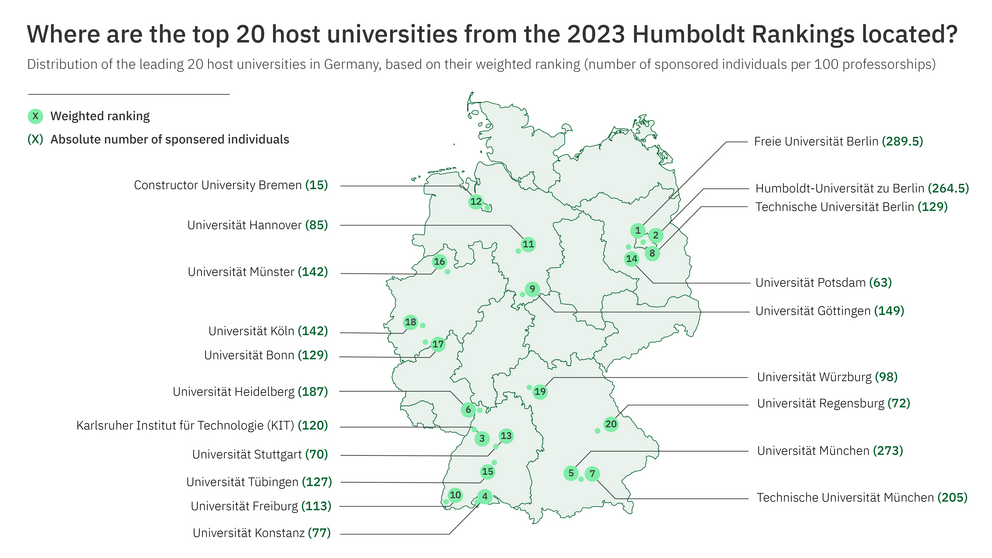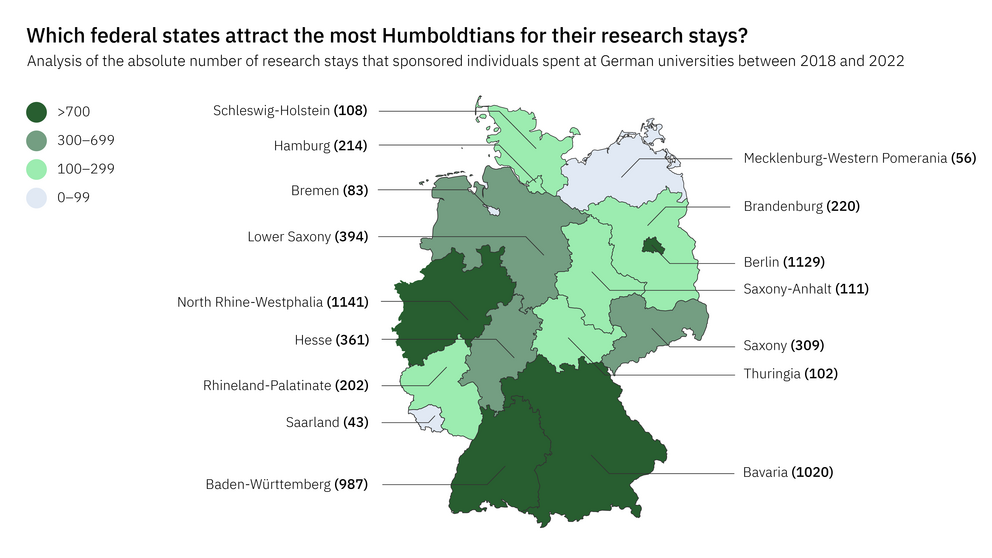
Contact
Press, Communications and Marketing
Tel.: +49 228 833-144
Fax: +49 228 833-441
presse[at]avh.de
The major universities in Berlin and Munich continue to be particularly popular among researchers and scholars from abroad, but their counterparts in smaller cities such as Karlsruhe, Konstanz, Heidelberg, Göttingen and Freiburg also have international appeal, according to the Humboldt Rankings released today.
The top positions are held by the Freie Universität Berlin and the Humboldt-Universität zu Berlin, followed by the Karlsruhe Institute of Technology (KIT), University of Konstanz and Ludwig-Maximilians-Universität München (LMU). Positions six to ten are held by Heidelberg University, the Technical University of Munich (TUM), Technische Universität Berlin, the University of Göttingen, and the University of Freiburg.

For the 2023 Humboldt Rankings, research stays undertaken by individuals sponsored by the Alexander von Humboldt Foundation during the time from 2018 to 2022 were analysed. The rankings show where in Germany researchers have worked during the past five years with the help of a Humboldt fellowship or award. To avoid statistical bias arising from differences in the size of the host institutions, the rankings relate the number of research stays to the number of professorships at the respective university.
"During the last five years, Humboldtians from other countries were hosted at 130 universities and more than 400 other institutions in Germany, including non-university research institutions, associations and companies. Each one of these nearly 6,500 research stays has enriched our science system with new ideas and impetus. Science thrives on a diversity of perspectives. Our fellowships must remain financially attractive and competitive so that particularly talented researchers choose Germany and funding from the Humboldt Foundation”, said Robert Schlögl, president of the Foundation, in view of imminent cuts to the Foundation’s budget by the German Government. “We are glad that we were able to recently increase the amount of our fellowships and awards slightly. But in the long term they should preferably be adapted dynamically.”

The Humboldt Rankings are issued for two different groups: universities and non-university research institutions and other institutions. Looking at non-university research institutions, Max Planck institutes head the list: The Max Planck Society’s Fritz Haber Institute in Berlin, the Max-Planck-Institut für Eisenforschung in Düsseldorf and the Max Planck Institute for Intelligent Systems in Stuttgart and Tübingen hold the top three positions.
The methodology used for the current rankings was modified in places in order to better reflect changes in the underlying conditions. As a result, the findings and rankings cannot be directly compared with those from the last rankings. Since each institute has strengths in certain fields, the Humboldt Rankings additionally list the absolute positions according to academic field.
(Press release 31/2023)
Every year, the Alexander von Humboldt Foundation enables more than 2,000 researchers from all over the world to spend time conducting research in Germany. The Foundation maintains an interdisciplinary network of well over 30,000 Humboldtians in more than 140 countries around the world – including 63 Nobel Prize winners.
